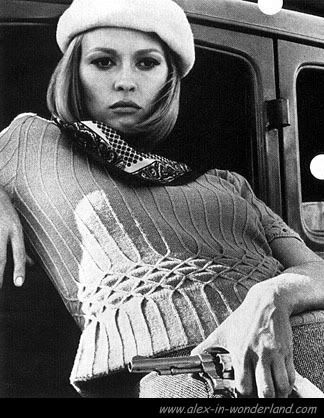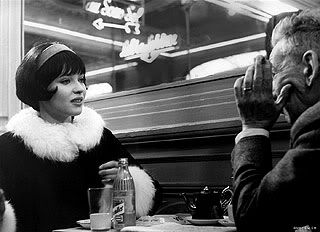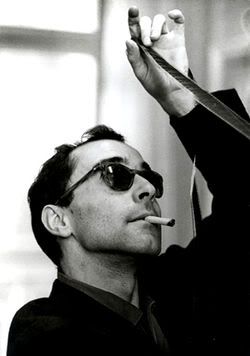
French New Wave cinema brought with it an explosion of individuality and embodied every sense of the word bold. Sidestepping the eccentric budgets of Hollywood and machismo/romantic themes, it produced a genre of its own by making full use of dramatic storytelling and imagery. This essay will detail the introduction and methodology of the French New Wave, or la Nouvelle Vague; how it differed from Western approaches to media and was controversial for its time; and the full-frontal approach it takes in confronting issues of key importance to the society it was unleashed upon.
As the product of rapidly evolving relationships between culture and society, French New Wave cinema brought social and political issues niggling in the minds of the people into the spotlight. By communicating messages at a deeper, more meaningful level, the genre met growing popularity with many French producers in releases such as La Jetee [The Jetty], Alphaville, and Vivre sa Vie [My Life to Lead]. Technological advances were employed in each, though inherently used unconventionally – selective use of snap-shots and dominating voice-over, or illusive use of the camera and one room to film what appears to be a complex, futuristic city.

The entrance of French New Wave media onto the scene of French upheaval in the late 50s, early 60s, was prompted by the desires of famous film critics. They developed auteur theory, or authorship visible from one work to the next, to expand the ways in which uses of technology and media could create a more interactive engagement with the audience to provoke and stir their minds on a much deeper level than popular Western conventions of the time. By using simplicity of procedure to get a complex idea across, the producers allowed interpretation and encouraged debate and discussion over the topic of choice.
This genre prompted the viewer to question the film before them, and then question their own surroundings – spreading the awareness that we currently live in a meditative world. Not through obvious, but rather instructional methods and routine, the society presented with this new class of media also began to question the other texts surrounding them. The efforts of authorities to conceal and repress today are being made more transparent. People realise the reactions that come when a constant theme, such as fear, is inspired – our personalities and the way we react to our environment can be dramatically shaped by the selective media before us.
With an innovative approach completely dissimilar to that of Western media, la Nouvelle Vague, largely owed its success to the ingenuity of its producers. French New Wave cinema selected with precision the concepts on the tip of society’s tongue and explored completely the ‘what if’s’ that lay unspoken. It was influential, unafraid to speak debate about time travel, or whether humanity could be controlled by a machine: What if humans were silenced and only instructed by their own creation – technology? What if we saw the last moment of our lives, then spent all our efforts on understanding it, inevitably leading us to it?

In La Jetee, French New Wave producers ventured into the unknown of time travel, incorporating themes of love and war, despite at an atmosphere of constant bombings. Still frames rather than rolling scenes were used to demonstrate creativity and present a scene that didn’t require the latest, greatest technology but relied on dynamic visual and auditory recordings to stir interactions deep within the core of the individual bearing witness to it.
A key concern within society stated so boldly French New Wave film, Alphaville, is the notion that, ‘the present is terrifying because it is irreversible – time is the substance of what [we are] made,’ (Godard, 1965). This film confronted the possibility of society controlled by a machine that produced logically-based orders. At its release into a war-torn and –paranoid environment, people held angst over the increasingly media-saturated environment that was developing around them – it inspired the debate of whether creativity, associated with human imagination, is more valuable than technology – an argument increasingly applicable today also.

In the French New Wave film, Vivre sa Vie, it would appear that the social structure that forces the poor into hopeless and unethical situations is investigated. However a closer look reveals that the producers sought to bring the viewers eye to the ways in which popular film conventions were being challenged by presenting the chapters of the film as a kind of split-screen storyboard and presenting documentary of sorts on the image of that lead female character. The audience is invited to broach and struggle through the many philosophical and existential dilemmas that she encounters.
The controversy that the genre brought at a time when parts of the world were experiencing state imposed media bans and all French media had to meet the pre-release approval of the national film review board was phenomenal. Although appreciated today by critics, historians and filmmakers alike, at its release it contrasted starkly against prior ideas of how the text should be constructed, confront and engage with the audience. Some within society argued that this new genre of film was stealing the value of literature texts – in portraying literature, the film began to usurp the function of the book rather than adapting to it (Williams, 1993).
 A ‘provider of possibilities’ for perception, French New Wave media influenced viewer sensitivity for modern ways of thinking about society, government and power at its release. As opposed to then, the movie-goer today has been so desensitized by exactly where Western media has progressed to – new levels of gore, special effects, and endless retelling of a few simple stories form a large majority of modern movie releases. This style of media has unknowingly conditioned us into looking at film sarcastically, searching for flaw and deconstructing the worth of the special effects.
A ‘provider of possibilities’ for perception, French New Wave media influenced viewer sensitivity for modern ways of thinking about society, government and power at its release. As opposed to then, the movie-goer today has been so desensitized by exactly where Western media has progressed to – new levels of gore, special effects, and endless retelling of a few simple stories form a large majority of modern movie releases. This style of media has unknowingly conditioned us into looking at film sarcastically, searching for flaw and deconstructing the worth of the special effects.Key elements that housed this category of film, French New Wave, on a shelf of its own included the ‘traditional quality’ that it so embraced. Producers focused on its technological and economic determinants and were gladly challenged in allowing creativity and innovation to shine through tight budgets. In recognizing that black-and-white film cost half as much as colour, and with the movement in value of French currency, opportunities opened up for this New Wave of cinema to be exposed to audiences abroad, breaking the chain of constant revival trends in fashion, film, music and literature still at work today in the Western world.
Now living in a culture the product of infinite revivalism, a key aim of our efforts is to create fresh, unique ideas. In Australia films such as Walkabout (1971), Alvin Purple (1973), and Ride a Wild Pony (1976), attempt to react against the dominant norms of cinema are again being made. Again, it has become apparent that the capacity for a text to involve itself with the audience and the scope of issues it confronts still surpass the importance of budget, popularity of the actor and nominations the text receives – film is yet another tool to keep society mentally alert and on its toes.
Bibliography
Danks, A (2000) ‘Vivre sa Vie’, Senses of Cinema, viewed 17 April 2007, <http://www.sensesofcinema.com/contents/cteq/00/5/vivre.html>
Godard, J (1965) ‘Alphaville’, viewed 10 May 2007, <http://www.lafn.org/~cymbala/alphavil.html>
Hilliker, Lee. "The History of the Future in Paris: Chris Marker and Jean-Luc Godard in the 1960s.(Critical Essay)." Film Criticism 24.3 (Spring 2000): 1. Expanded Academic ASAP. Thomson Gale. Griffith University Library. 1 May. 2007
Neupert, R (2002) Review: A History of the French New Wave Cinema, Oxford Journals: French Studies, viewed 20 April 2007, <
Phillips, C, French New Wave, Greencine, viewed 17 April 2007, <http://www.greencine.com/static/primers/fnwave1.jsp>
Rimanelli, David, and Tina Lyons. "Twist and crawl. (revivalism and New Wave) (Music) (Column)." Artforum International 31.n7 (March 1993): 7(1). Expanded Academic ASAP. Thomson Gale. Griffith University Library. 28 April. 2007
Steeples, Sheila, and Allen Katona. "Beyond the New Wave: four perspectives on French cinema.(producers Philippe Carcassonne and Gerard Vaugeois, studio official Margaret Menegoz and director Bruno Nuytten discuss current French film)(Interview)." Film Quarterly 49.n4 (Summer 1996): 2(14). Expanded Academic ASAP. Thomson Gale. Griffith University Library. 28 April. 2007
Villella, F ‘Editorial’ Senses of Cinema, viewed 25 April 2007, <
Walsh, Michael. "Building a New Wave: Australian Films and the American Market." Film Criticism 25.2 (Winter 2000): 21. Expanded Academic ASAP. Thomson Gale. Griffith University Library. 10 May. 2007
Williams, Alan. "Screening the Text: Intertextuality in New Wave French Cinema." Film Quarterly 46.n4 (Summer 1993): 52(2). Expanded Academic ASAP. Thomson Gale. Griffith University Library. 10 May. 2007
1 comment:
Experts have talked about this before. How many times have you read about the importance of ‘adding value’ for your audience? How many times have you read about ‘building trust’ with your readers/prospects?
Many, many times. You know it well. Every marketing guru has spoken about this topic. I’m sick of hearing it. But it STILL bears repeating.
www.onlineuniversalwork.com
Post a Comment